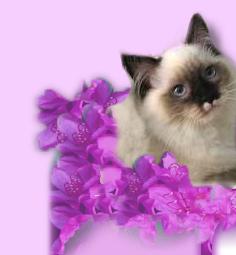
 |
 |

Home About Ragdolls Our Ragdolls Available Photo Gallery Contract Favorite Links Contact Us
 About Ragdolls
About Ragdolls
The Ragdoll is a Semi-Longhaired pointed cat of considerable size with a very Sweet and Docile dispostion. The name"Ragdoll" comes from the cats ability to become totally relaxed and "limp like a child's toy ragdoll." This characteristic is even more prevalent in mature Ragdolls than in kittens. The ideal Ragdoll grows exceptionaly large and heavy. Full developement of color is not achieved until two years of age. Full weight and size are not achieved until the cat is atleast four years of age. The Blue-Eyed, Pointed, Semi-Longhaired Ragdoll is one of the largest and most docile of all the cat breeds.

Ragdolls are Docile, Gentle, Quiet and Easy to get along with. They enjoy human companionship and seem to have a "Nothing Bothers Me" attitude toward life. They make sweet endearing pets and are very easy to show, due to their gentle nature. They are calm, yet moderately active and like to play. With their easy-going attitude, they usually get along well with other animals and children. Common traits characterized to the breed are:Friendly, Sweet, Loving, Docile, Gentle and Serene. A very sociable creature by nature Ragdolls are also easy to train and sometimes called a "Low-Maintenance Breed", as their long soft coat requires little to no grooming.
Ragdolls are very people-oriented "indoor cats" who love to be with humans and attach strongly to their owners. They also adapt well to live in a small apartment. In fact Ragdolls should "never go outside alone", because they are very trusting and tend to think of everyone as a friend.
However, one must keep in mind that the Ragdoll is also a large cat breed. They mature between 3 and 4 years of age --Female Ragdolls generally weigh about 8-15 pounds and Males about 12-20 pounds, making them up to three times bigger than "regular" cats!
Beautiful, normally quiet, easy to train, docile but playful, highly sociable and shedding very little, it's no wonder that "Ragdolls are one of the most popular breeds of indoor cats in the world."

Pros & Cons
Pros:
They are good house or apartment cats
Requires little or no routine grooming
Docile and affectionate
Has non-matting fur
Cons:
Due to its non-fighting instinct they should never be left outside unattended

COLORING
Ragdolls are born white and don't obtain their full coloring until about 2 years of age. They have beautiful, vivid blue eyes.
Recognized colors for Ragdolls are:
Seal - Dark brownish/black seal points with a light creamy/tan body color.
Chocolate - Chocolate points with a white/ivory body color
Light, Medium, or Dark shades are found in the breed.
Blue - Dark gray points with a creamy pale gray body color.
Lilac - Pinkish beige/gray points with an almost creamy white body color. Light, Medium, or Dark Lilac shades are found in the breed.
Flame - A deep rich orange.
Cream - Very light orange color.
Tortie - This color is a mixture of red or cream mixed with the traditional color of seal or blue points.

PATTERNS
In addition to the colors, Ragdolls traditionally come in three patterns. All Ragdolls are basically color point - The amount and location of white on the body determines whether the Ragdoll is Mitted or Bi-color.
Color Points: Body color is a Creamy White, with dark colorizations on the tail, face, ears, and feet.
Mitted: Same coloring as the color points but with white "mitts" on the front paws and "boots" on the back legs. Mitted colorization also include a white chest and chin, continuing along the stomach to the base of the tail.
Bi-color: An inverted, white "V" on the face, white chest and legs, with white spotting elsewhere, except for the points.
RARE PATTERNS INCLUDE:
Lynx Point: The striped effect is one of the precious patterns, a pointed version of a patterened tabby.
Tortie, Flame, Cream and Blue Cream Points: Tortie points are pointed-pattern calicos, Flames have Orange-Colored points, while Creams have Diluted-Orange points. Blue Cream are pointed dilute calicos.

![]()

 |
Copyright © All content All Dolled Up Ragdolls
|
 |
